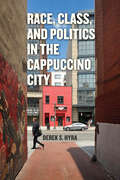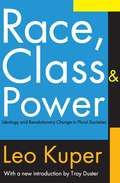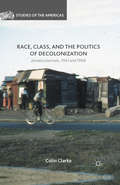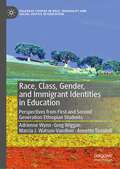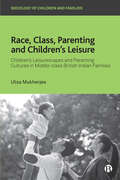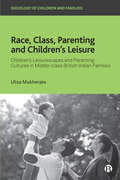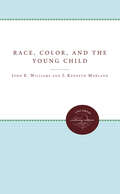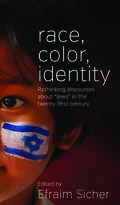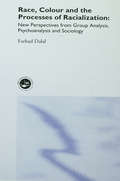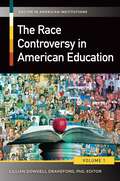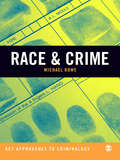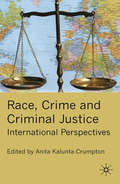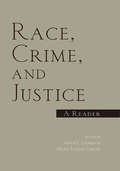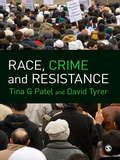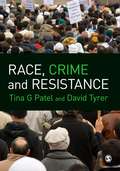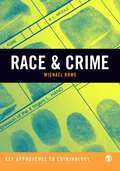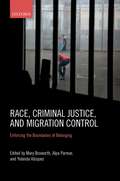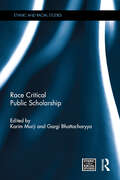- Table View
- List View
Race, Class, and Politics in the Cappuccino City
by Derek S. HyraFor long-time residents of Washington, DC’s Shaw/U Street, the neighborhood has become almost unrecognizable in recent years. Where the city’s most infamous open-air drug market once stood, a farmers’ market now sells grass-fed beef and homemade duck egg ravioli. On the corner where AM.PM carryout used to dish out soul food, a new establishment markets its $28 foie gras burger. Shaw is experiencing a dramatic transformation, from “ghetto” to “gilded ghetto,” where white newcomers are rehabbing homes, developing dog parks, and paving the way for a third wave coffee shop on nearly every block. Race, Class, and Politics in the Cappuccino City is an in-depth ethnography of this gilded ghetto. Derek S. Hyra captures here a quickly gentrifying space in which long-time black residents are joined, and variously displaced, by an influx of young, white, relatively wealthy, and/or gay professionals who, in part as a result of global economic forces and the recent development of central business districts, have returned to the cities earlier generations fled decades ago. As a result, America is witnessing the emergence of what Hyra calls “cappuccino cities.” A cappuccino has essentially the same ingredients as a cup of coffee with milk, but is considered upscale, and is double the price. In Hyra’s cappuccino city, the black inner-city neighborhood undergoes enormous transformations and becomes racially “lighter” and more expensive by the year.
Race, Class, and Politics in the Cappuccino City
by Derek S. HyraFor long-time residents of Washington, DC’s Shaw/U Street, the neighborhood has become almost unrecognizable in recent years. Where the city’s most infamous open-air drug market once stood, a farmers’ market now sells grass-fed beef and homemade duck egg ravioli. On the corner where AM.PM carryout used to dish out soul food, a new establishment markets its $28 foie gras burger. Shaw is experiencing a dramatic transformation, from “ghetto” to “gilded ghetto,” where white newcomers are rehabbing homes, developing dog parks, and paving the way for a third wave coffee shop on nearly every block. Race, Class, and Politics in the Cappuccino City is an in-depth ethnography of this gilded ghetto. Derek S. Hyra captures here a quickly gentrifying space in which long-time black residents are joined, and variously displaced, by an influx of young, white, relatively wealthy, and/or gay professionals who, in part as a result of global economic forces and the recent development of central business districts, have returned to the cities earlier generations fled decades ago. As a result, America is witnessing the emergence of what Hyra calls “cappuccino cities.” A cappuccino has essentially the same ingredients as a cup of coffee with milk, but is considered upscale, and is double the price. In Hyra’s cappuccino city, the black inner-city neighborhood undergoes enormous transformations and becomes racially “lighter” and more expensive by the year.
Race, Class, and Politics in the Cappuccino City
by Derek S. HyraFor long-time residents of Washington, DC’s Shaw/U Street, the neighborhood has become almost unrecognizable in recent years. Where the city’s most infamous open-air drug market once stood, a farmers’ market now sells grass-fed beef and homemade duck egg ravioli. On the corner where AM.PM carryout used to dish out soul food, a new establishment markets its $28 foie gras burger. Shaw is experiencing a dramatic transformation, from “ghetto” to “gilded ghetto,” where white newcomers are rehabbing homes, developing dog parks, and paving the way for a third wave coffee shop on nearly every block. Race, Class, and Politics in the Cappuccino City is an in-depth ethnography of this gilded ghetto. Derek S. Hyra captures here a quickly gentrifying space in which long-time black residents are joined, and variously displaced, by an influx of young, white, relatively wealthy, and/or gay professionals who, in part as a result of global economic forces and the recent development of central business districts, have returned to the cities earlier generations fled decades ago. As a result, America is witnessing the emergence of what Hyra calls “cappuccino cities.” A cappuccino has essentially the same ingredients as a cup of coffee with milk, but is considered upscale, and is double the price. In Hyra’s cappuccino city, the black inner-city neighborhood undergoes enormous transformations and becomes racially “lighter” and more expensive by the year.
Race, Class, and Power: Ideology and Revolutionary Change in Plural Societies
by Leo KuperExamining in detail the apparently inexorable polarization of society in such countries as Rwanda, Algeria, and South Africa, the author questions whether current theories correctly explain the past or offer adequate guides for the future. In their place he puts forward an alternative neo-Durkheimian view of the possibility of non-violent revolutionary change, based on the development of such social and cultural continuities as already exist within each plural society. But he warns that -this is an age of passionate commitment to violence in which vicarious killers abound in search of a Vietnam of their own.- The aim of this groundbreaking and challenging book is to create theoretical perspectives in which to view the racial conflict of plural societies. Written in the turbulent early 1970s, the book demonstrates the inadequacy of then prevailing views such as Marxist interpretations of racial conflict as class struggle, and the Fanon a priori rejection of non-violent techniques of change, which Kuper holds responsible for the acceptance of what he calls -the platitudes of violence.- The book concludes with more personal sections focusing on the author's struggles with the then prevailing South African society, critiques of that, and censorship of his attempts to make these public. In the light of subsequent changes in South Africa many decades later, this book serves not only as an important work of political sociology but as a personal testament to the fight against racism in South Africa. Leo Kuper was professor of sociology and director of the African Studies Center at the University of California, Los Angeles. A South African by birth, he was one of the first writers on genocide as well as other aspects of African studies and urban sociology. His major book, Genocide (Penguin, 1981), remains in print. The Leo Kuper Foundation is a non-governmental organization dedicated to the eradication of genocide through research, advice, and education. It was created in Washington, DC in 1994 following the death of Leo Kuper, with the aim of improving measures to prevent genocide. The main area of work for the past five years has been in support of the creation of an International Criminal Court. Troy Duster is director at the Institute for the History of the Production of Knowledge, New York University.
Race, Class, and Power: Ideology and Revolutionary Change in Plural Societies
by Leo KuperExamining in detail the apparently inexorable polarization of society in such countries as Rwanda, Algeria, and South Africa, the author questions whether current theories correctly explain the past or offer adequate guides for the future. In their place he puts forward an alternative neo-Durkheimian view of the possibility of non-violent revolutionary change, based on the development of such social and cultural continuities as already exist within each plural society. But he warns that -this is an age of passionate commitment to violence in which vicarious killers abound in search of a Vietnam of their own.- The aim of this groundbreaking and challenging book is to create theoretical perspectives in which to view the racial conflict of plural societies. Written in the turbulent early 1970s, the book demonstrates the inadequacy of then prevailing views such as Marxist interpretations of racial conflict as class struggle, and the Fanon a priori rejection of non-violent techniques of change, which Kuper holds responsible for the acceptance of what he calls -the platitudes of violence.- The book concludes with more personal sections focusing on the author's struggles with the then prevailing South African society, critiques of that, and censorship of his attempts to make these public. In the light of subsequent changes in South Africa many decades later, this book serves not only as an important work of political sociology but as a personal testament to the fight against racism in South Africa. Leo Kuper was professor of sociology and director of the African Studies Center at the University of California, Los Angeles. A South African by birth, he was one of the first writers on genocide as well as other aspects of African studies and urban sociology. His major book, Genocide (Penguin, 1981), remains in print. The Leo Kuper Foundation is a non-governmental organization dedicated to the eradication of genocide through research, advice, and education. It was created in Washington, DC in 1994 following the death of Leo Kuper, with the aim of improving measures to prevent genocide. The main area of work for the past five years has been in support of the creation of an International Criminal Court. Troy Duster is director at the Institute for the History of the Production of Knowledge, New York University.
Race, Class, and the Politics of Decolonization: Jamaica Journals, 1961 and 1968 (Studies of the Americas)
by Colin ClarkeThis book offers a detailed picture of Jamaica before and after independence. A 1961 journal sheds light on the political and social context before independence, while a 1968 journal shows how independence dissolved dissident forces and identifies the origins of Jamaica's current two party politics.
Race, Class, Gender, and Immigrant Identities in Education: Perspectives from First and Second Generation Ethiopian Students (Palgrave Studies in Race, Inequality and Social Justice in Education)
by Adrienne Wynn Greg Wiggan Marcia J. Watson-Vandiver Annette TeasdellThis volume addresses the underlying intersections of race, class, and gender on immigrant girls’ experiences living in the US. It examines the impact of acculturation and assimilation on Ethiopian girls’ academic achievement, self-identity, and perception of beauty. The authors employ Critical Race Theory, Critical Race Feminism, and Afrocentricity to situate the study and unpack the narratives shared by these newcomers as they navigate social contexts rife with racism, xenophobia, and other forms of oppression. Lastly, the authors examine the implications of Ethiopian immigrant identities and experiences within multicultural education, policy development, and society.
Race, Class, Parenting and Children’s Leisure: Children’s Leisurescapes and Parenting Cultures in Middle-class British Indian Families (Sociology of Children and Families)
by Utsa MukherjeeChildren’s leisure lives are changing, with increasing dominance of organised activities and screen-based leisure. These shifts have reconfigured parenting practices, too. However, our current understandings of these processes are race-blind and based mostly on the experiences of white middle-class families. Drawing on an innovative study of middle-class British Indian families, this book brings children’s and parents’ voices to the forefront and bridges childhood studies, family studies and leisure studies to theorise children’s leisure from a fresh perspective. Demonstrating the salience of both race and class in shaping leisure cultures within middle-class racialised families, this is an invaluable contribution to key sociological debates around leisure, childhoods and parenting ideologies.
Race, Class, Parenting and Children’s Leisure: Children’s Leisurescapes and Parenting Cultures in Middle-class British Indian Families (Sociology of Children and Families)
by Utsa MukherjeeChildren’s leisure lives are changing, with increasing dominance of organised activities and screen-based leisure. These shifts have reconfigured parenting practices, too. However, our current understandings of these processes are race-blind and based mostly on the experiences of white middle-class families. Drawing on an innovative study of middle-class British Indian families, this book brings children’s and parents’ voices to the forefront and bridges childhood studies, family studies and leisure studies to theorise children’s leisure from a fresh perspective. Demonstrating the salience of both race and class in shaping leisure cultures within middle-class racialised families, this is an invaluable contribution to key sociological debates around leisure, childhoods and parenting ideologies.
Race, Color, and the Young Child
by John Williams J. Kenneth MorlandA social-developmental psychologist and a social anthropologist describe what is known--and what needs to be investigated--concerning the development of race and color concepts in young children. The authors summarize the results of their fifteen-year research and integrate their findings with those of other investigators to provide, in a single source, a much-needed summary of the research literature and a more comprehensive theoretical analysis than has appeared previously.Originally published in 1976.A UNC Press Enduring Edition -- UNC Press Enduring Editions use the latest in digital technology to make available again books from our distinguished backlist that were previously out of print. These editions are published unaltered from the original, and are presented in affordable paperback formats, bringing readers both historical and cultural value.
Race, Color, Identity: Rethinking Discourses about 'Jews' in the Twenty-First Century
by Efraim SicherAdvances in genetics are renewing controversies over inherited characteristics, and the discourse around science and technological innovations has taken on racial overtones, such as attributing inherited physiological traits to certain ethnic groups or using DNA testing to determine biological links with ethnic ancestry. This book contributes to the discussion by opening up previously locked concepts of the relation between the terms color, race, and “Jews”, and by engaging with globalism, multiculturalism, hybridity, and diaspora. The contributors—leading scholars in anthropology, sociology, history, literature, and cultural studies—discuss how it is not merely a question of whether Jews are acknowledged to be interracial, but how to address academic and social discourses that continue to place Jews and others in a race/color category.
Race, Colour and the Processes of Racialization: New Perspectives from Group Analysis, Psychoanalysis and Sociology
by Farhad DalalIs racial conflict determined by biology or society?So many conflicts appear to be caused by racial and ethnic differences; for example, the cities of Britain and America are regularly affected by race riots. It is argued by socio-biologists and some schools of psychoanalysis that our instincts are programmed to hate those different to us by evolutionary and developmental mechanisms. This book argues against this line, proposing an alternative drawing on insights from diverse disciplines including anthropology, social psychology and linguistics, to give power-relations a critical explanatory role in the generation of hatreds. Farhad Dalal argues that people differentiate between races in order to make a distinction between the 'haves' and 'must-not-haves', and that this process is cognitive, emotional and political rather than biological. Examining the subject over the past thousand years, Race, Colour and the Processes of Racialisation covers:* psychoanalytic and other theories of racism* a new theorisation of racism based on group analytic theory* a general theory of difference based on the works of Fanon, Elias, Matte-Blanco and Foulkes* application of this theory to race and racism.Farhad Dalal concludes that the structures of society are reflected in the structures of the psyche, and both of these are colour coded. This book will be invaluable to students, academics and practitioners in the areas of psychoanalysis, group analysis, psychotherapy and counselling.
Race, Colour and the Processes of Racialization: New Perspectives from Group Analysis, Psychoanalysis and Sociology
by Farhad DalalIs racial conflict determined by biology or society?So many conflicts appear to be caused by racial and ethnic differences; for example, the cities of Britain and America are regularly affected by race riots. It is argued by socio-biologists and some schools of psychoanalysis that our instincts are programmed to hate those different to us by evolutionary and developmental mechanisms. This book argues against this line, proposing an alternative drawing on insights from diverse disciplines including anthropology, social psychology and linguistics, to give power-relations a critical explanatory role in the generation of hatreds. Farhad Dalal argues that people differentiate between races in order to make a distinction between the 'haves' and 'must-not-haves', and that this process is cognitive, emotional and political rather than biological. Examining the subject over the past thousand years, Race, Colour and the Processes of Racialisation covers:* psychoanalytic and other theories of racism* a new theorisation of racism based on group analytic theory* a general theory of difference based on the works of Fanon, Elias, Matte-Blanco and Foulkes* application of this theory to race and racism.Farhad Dalal concludes that the structures of society are reflected in the structures of the psyche, and both of these are colour coded. This book will be invaluable to students, academics and practitioners in the areas of psychoanalysis, group analysis, psychotherapy and counselling.
The Race Controversy in American Education [2 volumes]: [2 volumes] (Racism in American Institutions)
by Lillian Dowdell Drakeford Brian D. BehnkenIn this unique two-volume work, expert scholars and practitioners examine race and racism in public education, tackling controversial educational issues such as the school-to-prison pipeline, charter schools, school funding, affirmative action, and racialized curricula.This work is built on the premise that recent efforts to advance color-blind, race-neutral educational policies and reforms have not only proven ineffective in achieving racial equity and equality of educational opportunities and outcomes in America's public schools but also exacerbated existing inequalities. That point is made through a collection of essays that examine the consequences of racial inequality on the school experience and success of students of color and other historically marginalized populations.Addressing K–12 education and higher education in historically black as well as predominantly white institutions, the work probes the impact of race and racism on education policies and reforms to determine the role schools, school processes, and school structures play in the perpetuation of racial inequality in American education. Each volume validates the impact of race on teaching and learning and exposes the ways in which racism manifests itself in U.S. schools. In addition, practical recommendations are presented that may be used to confront and eradicate racism in education. By exposing what happens when issues of race and racism are marginalized or ignored, this collection will prepare readers to resist—and perhaps finally overcome—the racial inequality that plagues America's schools.
The Race Controversy in American Education [2 volumes]: [2 volumes] (Racism in American Institutions)
In this unique two-volume work, expert scholars and practitioners examine race and racism in public education, tackling controversial educational issues such as the school-to-prison pipeline, charter schools, school funding, affirmative action, and racialized curricula.This work is built on the premise that recent efforts to advance color-blind, race-neutral educational policies and reforms have not only proven ineffective in achieving racial equity and equality of educational opportunities and outcomes in America's public schools but also exacerbated existing inequalities. That point is made through a collection of essays that examine the consequences of racial inequality on the school experience and success of students of color and other historically marginalized populations.Addressing K–12 education and higher education in historically black as well as predominantly white institutions, the work probes the impact of race and racism on education policies and reforms to determine the role schools, school processes, and school structures play in the perpetuation of racial inequality in American education. Each volume validates the impact of race on teaching and learning and exposes the ways in which racism manifests itself in U.S. schools. In addition, practical recommendations are presented that may be used to confront and eradicate racism in education. By exposing what happens when issues of race and racism are marginalized or ignored, this collection will prepare readers to resist—and perhaps finally overcome—the racial inequality that plagues America's schools.
Race & Crime
by Michael RoweIn this original and cutting-edge new textbook, Mike Rowe explores the key topics in race and crime. Examining the main issues from a historical and comparative approach, the book fully situates arguments and ideas in a global context with contemporary examples. Encouraging readers to think critically about well-worn debates, Race & Crime covers a diverse range of issues, including: Representation and Disproportionality Victimisation Human Rights Terrorism Popular Culture Governance As with all books in the Key Approaches to Criminology series, Race & Crime features extensive learning features to help students to fully engage with topics covered. These include: chapter overviews, study questions, further reading and key terms. Stylishly written yet accessible, Race & Crime will prove invigorating, vital reading for students in criminology, sociology, race and ethnic studies, and cultural studies. The Key Approaches to Criminology series celebrates the removal of traditional barriers between disciplines and, specifically, reflects criminology’s interdisciplinary nature and focus. It brings together some of the leading scholars working at the intersections of criminology and related subjects. Each book in the series helps readers to make intellectual connections between criminology and other discourses, and to understand the importance of studying crime and criminal justice within the context of broader debates. The series is intended to have appeal across the entire range of undergraduate and postgraduate studies and beyond, comprising books which offer introductions to the fields as well as advancing ideas and knowledge in their subject areas.
Race, Crime and Criminal Justice: International Perspectives
by A. Kalunta-CrumptonThis book provides a focused and critical international overview of the intersections between race, crime perpetration and victimization, and criminal justice policy and practice responses to crime perpetration and crime victimization.
Race, Crime, and Justice: A Reader (Sage Text/reader Series In Criminology And Criminal Justice Ser.)
by Shaun L. Gabbidon Helen Taylor GreeneA comprehensive collection of the essential writings on race and crime, this important Reader spans more than a century and clearly demonstrates the long-standing difficulties minorities have faced with the justice system. The editors skillfully draw on the classic work of such thinkers as W.E.B. DuBois and Gunnar Myrdal as well as the contemporary work of scholars such as Angela Davis, Joan Petersilia, John Hagen and Robert Sampson. This anthology also covers all of the major topics and issues from policing, courts, drugs and urban violence to inequality, racial profiling and capital punishment. This is required reading for courses in criminology and criminal justice, legal studies, sociology, social work and race.
Race, Crime, and Justice: A Reader
by Shaun L. Gabbidon Helen Taylor GreeneA comprehensive collection of the essential writings on race and crime, this important Reader spans more than a century and clearly demonstrates the long-standing difficulties minorities have faced with the justice system. The editors skillfully draw on the classic work of such thinkers as W.E.B. DuBois and Gunnar Myrdal as well as the contemporary work of scholars such as Angela Davis, Joan Petersilia, John Hagen and Robert Sampson. This anthology also covers all of the major topics and issues from policing, courts, drugs and urban violence to inequality, racial profiling and capital punishment. This is required reading for courses in criminology and criminal justice, legal studies, sociology, social work and race.
Race, Crime and Resistance
by Dr David Tyrer Tina G. PatelIn a post-Macpherson, post-9/11 world, criminal justice agencies are adapting their responses to criminal behaviour across diverse ethnic groups. Race, Crime and Resistance draws on contemporary theory and a range of case studies to consider racial inequalities within the criminal justice system and related organisations. Exploring the mechanisms of discrimination and exclusion, the book goes beyond superficial assumptions to examine the ensuing processes of mobilisation and resistance across disadvantaged groups. Empirically grounded and theoretically informed, the book critically unpicks the persisting concepts of race and ethnicity in the perceptions and representations of crime. Articulate and sensitive, the book clarifies complex ideas through the use of chapter summaries, case studies, further reading and study questions. It is essential reading for students and scholars of criminology, race and ethnicity, and sociology.
Race, Crime and Resistance (PDF)
by Tina G. Patel Dr David TyrerIn a post-Macpherson, post-9/11 world, criminal justice agencies are adapting their responses to criminal behaviour across diverse ethnic groups. Race, Crime and Resistance draws on contemporary theory and a range of case studies to consider racial inequalities within the criminal justice system and related organisations. Exploring the mechanisms of discrimination and exclusion, the book goes beyond superficial assumptions to examine the ensuing processes of mobilisation and resistance across disadvantaged groups. Empirically grounded and theoretically informed, the book critically unpicks the persisting concepts of race and ethnicity in the perceptions and representations of crime. Articulate and sensitive, the book clarifies complex ideas through the use of chapter summaries, case studies, further reading and study questions. It is essential reading for students and scholars of criminology, race and ethnicity, and sociology.
Race & Crime (PDF)
by Michael RoweIn this original and cutting-edge new textbook, Mike Rowe explores the key topics in race and crime. Examining the main issues from a historical and comparative approach, the book fully situates arguments and ideas in a global context with contemporary examples. Encouraging readers to think critically about well-worn debates, Race & Crime covers a diverse range of issues, including: Representation and Disproportionality Victimisation Human Rights Terrorism Popular Culture Governance As with all books in the Key Approaches to Criminology series, Race & Crime features extensive learning features to help students to fully engage with topics covered. These include: chapter overviews, study questions, further reading and key terms. Stylishly written yet accessible, Race & Crime will prove invigorating, vital reading for students in criminology, sociology, race and ethnic studies, and cultural studies. The Key Approaches to Criminology series celebrates the removal of traditional barriers between disciplines and, specifically, reflects criminology’s interdisciplinary nature and focus. It brings together some of the leading scholars working at the intersections of criminology and related subjects. Each book in the series helps readers to make intellectual connections between criminology and other discourses, and to understand the importance of studying crime and criminal justice within the context of broader debates. The series is intended to have appeal across the entire range of undergraduate and postgraduate studies and beyond, comprising books which offer introductions to the fields as well as advancing ideas and knowledge in their subject areas.
Race, Criminal Justice, and Migration Control: Enforcing the Boundaries of Belonging
by Mary Bosworth, Alpa Parmar and Yolanda VáZquezThe criminalization of migration is heavily patterned by race. By placing race at the centre of its analysis, this volume examines, questions, and explains the growing intersection between criminal justice and migration control. Through the lens of race, we see how criminal justice and migration enmesh in order to exclude, stop, and excise racialized citizens and non-citizens from societies across the world within, beyond, and along borders. Race and the meaning of race in relation to citizenship and belonging is excavated through the chapters presented in the book, and the book as a whole, thereby transforming the way we think about migration. Neatly organized in four sections, the book begins with chapters that present a conceptual analysis of race, borders, and social control, moving to the institutions that make up and shape the criminal justice and migration complex. The remaining chapters are convened around the key sites where criminal justice and migration control intersect: policing, courts, and punishment. Together the volume presents a critical and timely analysis of how race shapes and complicates mobility and how racism is enabled and reanimated when criminal justice and migration control coalesce.
Race, Criminal Justice, and Migration Control: Enforcing the Boundaries of Belonging
The criminalization of migration is heavily patterned by race. By placing race at the centre of its analysis, this volume examines, questions, and explains the growing intersection between criminal justice and migration control. Through the lens of race, we see how criminal justice and migration enmesh in order to exclude, stop, and excise racialized citizens and non-citizens from societies across the world within, beyond, and along borders. Race and the meaning of race in relation to citizenship and belonging is excavated through the chapters presented in the book, and the book as a whole, thereby transforming the way we think about migration. Neatly organized in four sections, the book begins with chapters that present a conceptual analysis of race, borders, and social control, moving to the institutions that make up and shape the criminal justice and migration complex. The remaining chapters are convened around the key sites where criminal justice and migration control intersect: policing, courts, and punishment. Together the volume presents a critical and timely analysis of how race shapes and complicates mobility and how racism is enabled and reanimated when criminal justice and migration control coalesce.
Race Critical Public Scholarship (Ethnic and Racial Studies)
by Karim Murji Gargi BhattacharyyaKarim Murji is Senior Lecturer in Sociology at the Open University, UK. He writes on cultural and policy studies of ethnicity and racism, and criminology. With John Solomos, he is the editor of Racialization: Studies in theory and practice (2005) and Theories of Race and Ethnic Relations. He is an Editor of the journal Sociology.Gargi Bhattacharyya is Professor of Sociology at the University of East London, UK. She has written on issues of racism and sexuality, global cultures of racism and the war on terror. Her recent work includes Dangerous Brown Men: Exploiting Sex, Violence and Feminism in the War on Terror (2008) and the edited collection Ethnicities and Values in a Changing World (2009).
